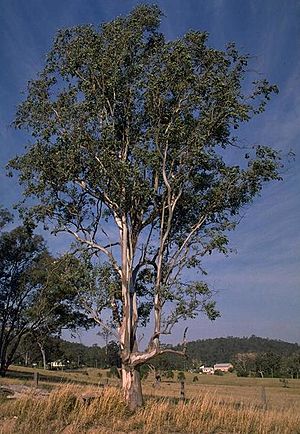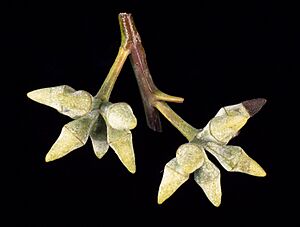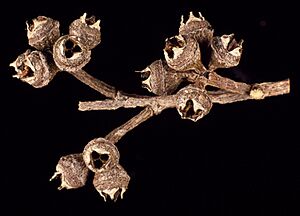Slaty red gum facts for kids
Quick facts for kids Slaty red gum |
|
|---|---|
 |
|
| Conservation status | |
| Scientific classification | |
| Genus: |
Eucalyptus
|
| Species: |
glaucina
|
| Synonyms | |
|
|
The Eucalyptus glaucina, also known as the slaty red gum, is a special kind of tree. It is a small to medium-sized tree that grows only in New South Wales, Australia. This means it is endemic to that area.
This tree has smooth bark that is white and grey. Its adult leaves are shaped like a spear. The tree's flower buds grow in groups of seven, and the flowers are white. After flowering, it produces fruit that looks like a half-sphere, with parts sticking out from the top.
Contents
What the Slaty Red Gum Looks Like
The slaty red gum is a tree that usually grows to be about 18 m (59 ft) to 30 m (98 ft) tall. It has a special woody swelling at its base called a lignotuber. This helps the tree regrow if it gets damaged, like from a bushfire.
Its bark is smooth and has patches of white and grey. It peels off in large pieces. Young plants and new shoots have leaves that are egg-shaped or almost round. These leaves are a bluish-green color, sometimes even a bit waxy or "glaucous." They are about 60 mm (2.4 in) to 100 mm (3.9 in) long and 50 mm (2.0 in) to 65 mm (2.6 in) wide.
The adult leaves grow in an alternating pattern along the branches. They are a dull green to bluish color on both sides. These leaves are longer, about 90 mm (3.5 in) to 170 mm (6.7 in) long and 20 mm (0.79 in) to 42 mm (1.7 in) wide. Each leaf has a stalk called a petiole, which is about 10 mm (0.39 in) to 28 mm (1.1 in) long.
The flower buds are also bluish or waxy at first. They grow in groups of seven in the leaf axils (where the leaf meets the stem). These groups are on a single stalk called a peduncle, which is about 7 mm (0.28 in) to 20 mm (0.79 in) long. Each individual bud has its own small stalk, called a pedicel, about 3 mm (0.12 in) to 7 mm (0.28 in) long.
When the buds are ready to open, they are oval or diamond-shaped. They measure about 9 mm (0.35 in) to 14 mm (0.55 in) long and 4 mm (0.16 in) to 7 mm (0.28 in) wide. The top part of the bud, which covers the flower, is shaped like a cone or a horn. Slaty red gums have been seen flowering in November, and their flowers are white.
After the flowers, the tree produces a woody fruit. This fruit is a capsule that looks like a half-sphere. It is about 3 mm (0.12 in) to 6 mm (0.24 in) long and 6 mm (0.24 in) to 10 mm (0.39 in) wide. The most noticeable part is that the "valves" (the parts that open to release seeds) stick out quite a bit from the rim of the fruit.
How the Slaty Red Gum Got Its Name
The way scientists name and classify living things is called taxonomy. The slaty red gum was first officially described in 1934 by a scientist named William Blakely. He first called it Eucalyptus umbellata var. glaucina. This name was published in his book, A Key to the Eucalypts. The specimens he used to describe it were collected by John L. Boorman.
Later, in 1962, another scientist named Lawrie Johnson decided that this plant was different enough to be its own species. So, he changed its name to E. glaucina, which is the name we use today.
Where the Slaty Red Gum Lives
The slaty red gum grows in areas with grassy woodlands and forests. In the past, it could be found in several places in New South Wales, like the Casino, Taree, Stroud, Dungog, and Paterson districts.
However, today, this tree is only protected in one special nature reserve near Casino. This shows how rare it has become.
Protecting the Slaty Red Gum
The slaty red gum is considered a "vulnerable" species. This means it is at risk of becoming extinct if we don't protect it. Both the Australian Government and the New South Wales Government have laws to protect it. These laws are the Environment Protection and Biodiversity Conservation Act 1999 and the Biodiversity Conservation Act 2016.
The biggest problems for the slaty red gum are:
- Loss of habitat: Its natural home is being cleared for other uses, like farming or building.
- Lack of new trees: Animals grazing (eating plants) can stop new young trees from growing.
- Mixing with other trees: It can sometimes mix with other types of red gums, which can change its unique features.
Protecting these trees helps keep our natural environment healthy and diverse.




